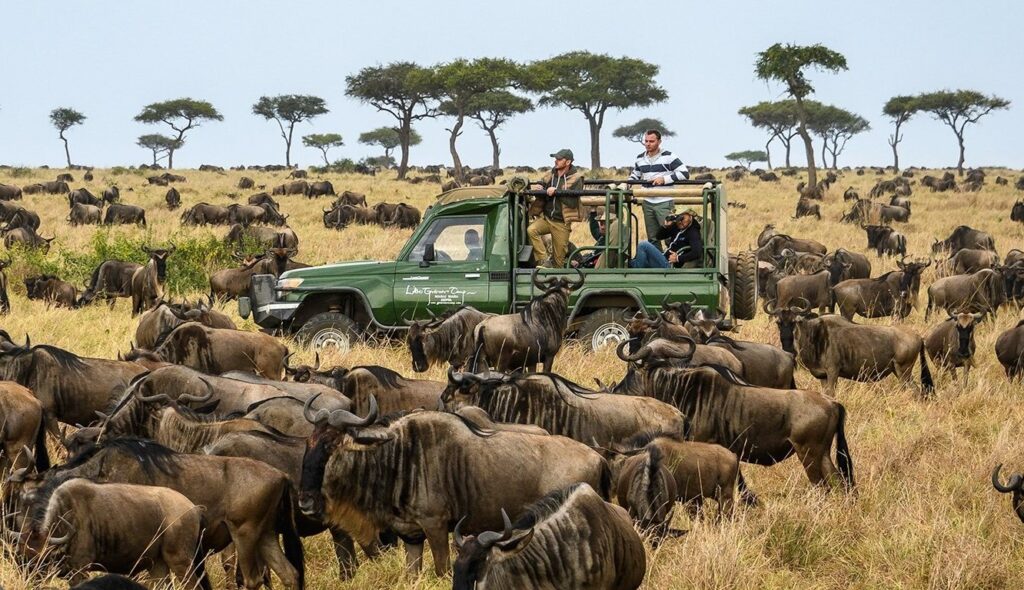Seronera Valley, Central Serengeti
Seronera Valley, the Seronera River Valley, located at the park’s center, is a premier wildlife habitat, serving as a crucial water source and delineating the transition between the grassy plains and the northern wooded hills, thereby attracting fauna and avifauna from both ecosystems. Seronera, the location of the park headquarters, its oldest lodge, a visitor center, and multiple public campsites, is the most frequented area of the park for tourist traffic, leading to its avoidance by more exclusive safaris.
Seronera Valley, Seronera serves as the hub for Serengeti Balloon Safaris, offering an enchanting experience of gliding over the expansive landscape at dawn, occasionally descending to brush the treetops, while at other times ascending to appreciate the immense size of this huge wilderness. Notwithstanding the substantial influx of tourists, Seronera provides consistent and exceptional game viewing year-round. The woods is inhabited by olive baboons, vervet monkeys, buffalo, giraffe, elands, bushbucks, and dik-diks, in addition to standard plains grazers. Waterbucks and reedbucks congregate along the riverbanks, and several species of the park’s over 500 avian varieties inhabit the vicinity.

Approximately 15 kilometers (9 miles) north of the park headquarters, the Retima Hippo Pool, situated at the confluence of the Seronera and Grumeti rivers, typically accommodates several dozen hippos basking in close proximity. Seronera is the premier location in Tanzania for observing leopards, which often repose in the shade of the sausage trees and acacias along the river, disclosing their presence only through an intermittent flick of the tail. The region hosts numerous lethargic lion prides that have increasingly adopted arboreal habits in recent years; in fact, sightings of lions engaging in such behavior are now more common in Seronera than in Lake Manyara, which was formerly renowned for this peculiarity.
The Seronera Visitor Centre, expertly designed, is an excellent destination following an early-morning wildlife drive. It is a genuine delight to integrate permanent exhibits, displays, and wildlife film screenings during lunchtime, alongside a hilarious informational walk around a local kopje. Additionally, there exists a shop offering beverages and snacks, as well as a picnic area where semi-tame rock hyraxes and avian species, including hoopoes and charming Fischer’s lovebirds, observe your meal. The center’s gift store ought to provide a brochure with information from the trail, as well as a leaflet featuring a map and comprehensive explanations of the many game drives in Seronera. The personnel can typically provide information on recent predator sightings and road conditions, and some park wardens are stationed here to address more specific inquiries.
Seronera Wildlife Drive Routes
A brief overview of the primary paths ensues. The majority feature numbered road intersections that align with those on the brochure provided by the visitor center. The Seronera River Circuit (junctions 1–26) commences at Seronera Hippo Pool and traverses the river, providing opportunities to observe lions, leopards, crocodiles, and waterbuck, in addition to hippos, giraffes, vervet monkeys, baboons, and many avian species. The circuit can be integrated with the Kopjes Circuit (junctions 52–62; access via junction 18 on the eastern side of the Seronera River), which traverses anticlockwise around Maasai, Loliondo, and Boma Kopjes. Rock climbing is prohibited. The Hills Circuit (junctions 27–29) traverses grassland leading to the forested foothills of the Makori and Makoma Hills, situated west of the Seronera Valley, and is conducive for observing hyenas, zebras, ostriches, warthogs, gazelles, topis, and hartebeests.
A journey around this circuit is optimally paired with the Songore River Circuit (junctions 30–34), which encircles the plains south of the Seronera River. Thomson’s gazelle, Grant’s gazelle, topi, hartebeest, and ostrich are commonly observed, as are cheetahs during the arid season. Finally, the Wandamu River Circuit (junctions 40–49) encompasses ecosystems akin to those of the Seronera River Circuit and closely follows the banks of the Wandamu River, which is particularly frequented by buffaloes.
The Central Plains
The undulating, semi-arid Serengeti Plains constitute the foundation of the Serengeti ecosystem. To obtain a panoramic perspective, ascend the kopje located behind Naabi Hill Gate; this vantage point and picnic area is optimal for witnessing the migration from January to April, particularly in February and March when vast numbers of wildebeest, zebra, and gazelle graze across the grasslands beneath. The plains’ appeal to wildlife seems attributable to the soil’s alkaline composition, enriched by volcanic ash deposited during the eruptions of Ngorongoro’s Crater Highlands, and further enhanced by the annual cycle of precipitation and evaporation that draws minerals to the surface. Calcium, potassium carbonate, and sodium carbonate are the primary components that recent research indicate are vital for the diets of many animals, particularly during lactation, which elucidates why eighty percent of the Serengeti’s wildebeest give birth on these plains.
Despite the migration departing the region and the Central plains transforming into a parched expanse of straw, a substantial population of resident animals persists, including lion prides, notably huge clans of hyenas (up to eighty members), as well as hartebeest, topi, warthog, and ostrich. Avian diversity peaks during the rainy season; nevertheless, secretary birds and kori bustards are observable year-round. The black-throated honey guide is another avian species notable for its unique symbiotic association with the ratel (honey badger). The honeyguide, as indicated by its name, directs the ratel to wild beehives in trees, which the ratel – apparently impervious to stings – dismantles and opens. The ratel consumes honey, whereas the honey guide indulges in beeswax.
